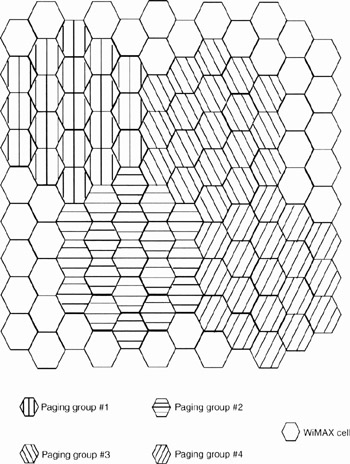14.5 Power-Save Modes
14.5 Power-Save Modes
IEEE 802.16e defines two new modes: the Sleep mode and the Idle mode in order to have:
-
power-efficient MS operation;
-
a more efficient handover.
Consequently, the normal operation mode that exists in 802.16-2004 is known as the Active mode.
14.5.1 Sleep Mode
In the Sleep mode state, the MS conducts pre-negotiated periods of absence from the serving BS air interface. The MS is unavailable to the serving BS (downlink and uplink) in these periods. The Sleep mode objectives are the following [2]:
-
minimise MS power usage;
-
minimise the usage of the serving base station air interface resources.
In addition, the MS can scan other base stations to collect information to assist handover during the Sleep mode. Implementation of the Sleep mode is optional for the MS and mandatory for the BS.
For each MS in the Sleep mode, its BS keeps one or several contexts, each one related to a certain Sleep mode power saving class. The power saving class is a group of connections that have common demand properties. There are three types of power saving class, which differ by their parameter sets, procedures of activation/deactivation and policies of MS availability for data transmission. The MOB_SLP-REQ (SLeeP Request Message) (sent by a Sleep mode supporting MS) and the MOB_SLP-RSP (SLeeP Response Message) (sent by the BS) allow a request to be made for a definition and/or activation of certain Sleep mode power-save classes.
The unavailability interval of an MS is a time interval that does not overlap with any listening window of any active power saving class of this MS. During the unavailability interval the BS does not transmit to the MS, so the MS may power down or perform other activities that do not require communication with the BS, such as scanning neighbour BSs, associating with neighbour BSs, etc. During unavailability intervals for the MS, the BS may buffer (or it may drop) MAC SDUs addressed to unicast connections bound to the MS.
14.5.2 Idle Mode
The Idle mode is intended as a mechanism to allow the MS to become periodically available for downlink broadcast traffic messaging without registration at a specific BS as the MS traverses an air link environment populated by multiple BSs, typically over a large geographic area [2]. The Idle mode benefits the MSs by removing the active requirement for handovers and all Active mode normal operation requirements. By restricting MS activity to scanning at discrete intervals, the Idle mode allows the MS to conserve power and operational resources. The Idle mode also benefits the network and the BSs by eliminating air interface and network handover traffic from essentially inactive MSs while still providing a simple and fast method (paging) for alerting the MS about pending downlink traffic.
The BS are divided into logical groups called paging groups. The purpose of these groups is to offer a contiguous coverage region (see Figure 14.5) in which the MS does not need to transmit in the uplink yet can be paged in the downlink if there is traffic targeted at it. The paging groups have to be large enough so that most MSs will remain within the same paging group most of the time and small enough such that the paging overhead is reasonable. A BS may be a member of one or more paging groups.

Figure 14.5: Example of paging groups. (Based on Reference [2].)
The MOB_PAG-ADV (BS broadcast PAGing) message is sent by the BS on the Broadcast CID or Idle mode multicast CID during the BS paging interval. This message indicates for a number of Idle mode supporting MSs a requirement to perform ranging to establish location and acknowledge a message or to enter the network. An MS will terminate the Idle mode and re-enter the network if it decodes a MOB_PAG-ADV message that contains the MS MAC address and an action code of 0b10 (Network Entry).
Idle mode initiation may begin after MS de-registration. During the Active mode normal operation with its serving BS, an MS may signal intent to begin the Idle mode by sending a DREG-REQ message with a De-Registration_Request_Code = 0 X 01, indicating a request for MS de-registration from a serving BS and initiation of the MS Idle mode. At MS Idle mode initiation, an MS may engage in cell selection to obtain a new preferred BS. A preferred BS is a neighbour BS that the MS evaluates and selects as the BS with the best air interface downlink properties.
The Idle mode can also be BS initiated: the serving BS includes a REQ duration TLV with an Action code = 0 × 05 in the DREG-CMD message, signalling for an MS to initiate an Idle mode request.
EAN: 2147483647
Pages: 124